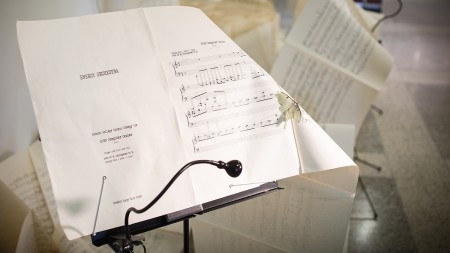
Photo: Tom Kates
The score represents electricity use for one year at Reynolds, Olin Hall, the Babson Skating Center, Horn Library, and the Horn Computer Center.
Flick on a light. Crank up the air conditioning. Turn on the television. Energy is almost like oxygen; it supports modern day life. We use it 24/7. Refrigerators run. Safety lights illuminate. Even when off, some electronic devices draw electricity.
Similar to breathing, we don’t think much about our energy consumption. To raise awareness of energy use, artist Deb Todd Wheeler created Surge, a multi-sensory exhibit that represents one year of electricity use of five Babson buildings. The exhibit, curated by Danielle Krcmar, artist in residence at Babson, includes an audio composition of five musical movements produced from actual data of the five buildings’ electricity expenditure. A video accompanies the composition, to “lure the passer-by into stopping to take in the sound,” says Wheeler. Next to the video projection is a flowing sculpture made from a printout of the musical score (above photo).
While conceiving and developing the exhibit, Wheeler collaborated with sev-eral groups, including Babson facilities, who provided her with the kilowatt-hour energy use of the buildings—a spreadsheet with more than 86,000 numbers. Art students from Wellesley College suggested Wheeler explore working with sound for the exhibit, and sound artist and Emerson College professor Maurice Methot helped her translate the numbers into a composition. Each number, which represents a kilowatt-hour of electricity usage, would equal a note, decided Wheeler, with low-usage numbers being low tones and, conversely, high-usage numbers being high tones.
“The higher tones make the intensity of use an unappealing stimulus,” says Krcmar. “It’s intentional—that kind of getting under your skin. She wants you to realize that intensity of use isn’t something that we should be striving for. The lower pitch is more musical and soothing.”
Four of the movements were played on a digital synthesizer. The fifth was played on the piano by Wheeler’s brother and mother, who are skilled sight readers. The duet brings the digital data back to “analog human energy,” says Wheeler. Several of the videos show their two sets of hands playing. Other videos, which Wheeler both filmed and found, include footage of moths set to the scores. “I used the moth’s innate attraction to light as a visual anal-ogy to our own unquestioning dependence on electricity,” she says. Preserved moths also were placed in various spots on the sculpture.
“In some ways, we are so exposed to data all the time that we are almost a little numb to it,” says Krcmar, “and numbers become like a word that’s repeated too often. We don’t really think about what they mean. The exhibit kind of hits you on a visceral level where your teeth grate a little bit on the high notes and you think, well, maybe those numbers are a problem.” At the same time, the visual sculpture of the composition, while conveying a sense of intensity through its continuous unraveling, is quite beautiful, she says.
Wheeler says the exhibit isn’t overtly telling people what they should think about energy consumption. It is striving to represent an intangible element— energy consumption—via sound and visuals. “Right now use is invisible, abstract, except when the electric bill comes to our homes,” she says. “I guess this is one of the many wonderful things about the value of art in our culture, providing a place for creative experiments that reflect back on the way we live.”—Donna Coco
